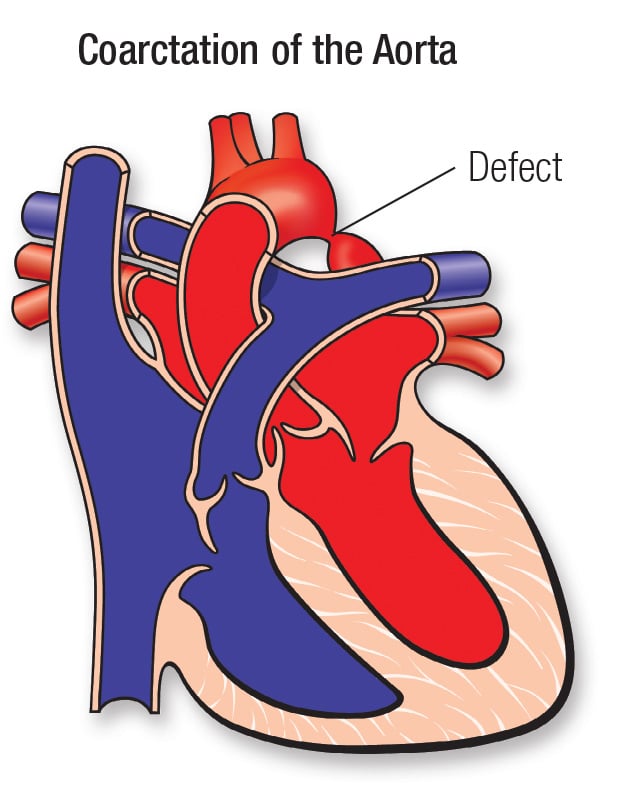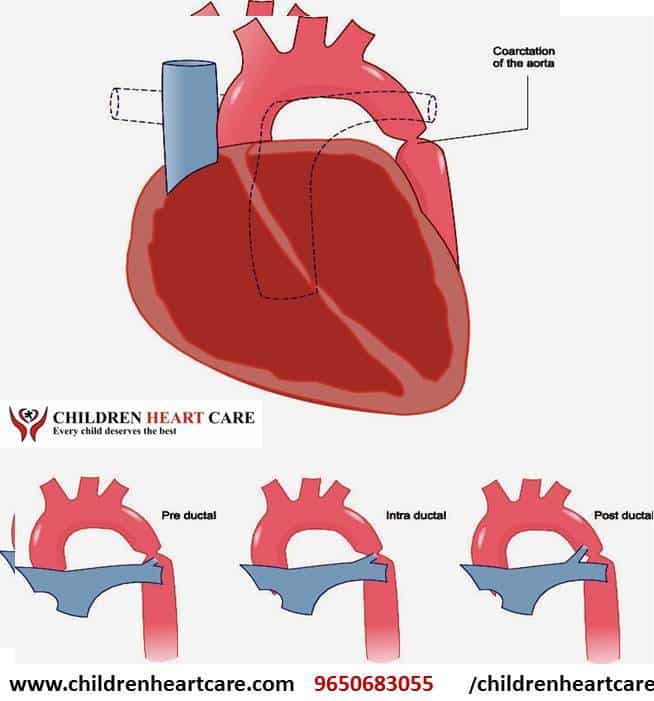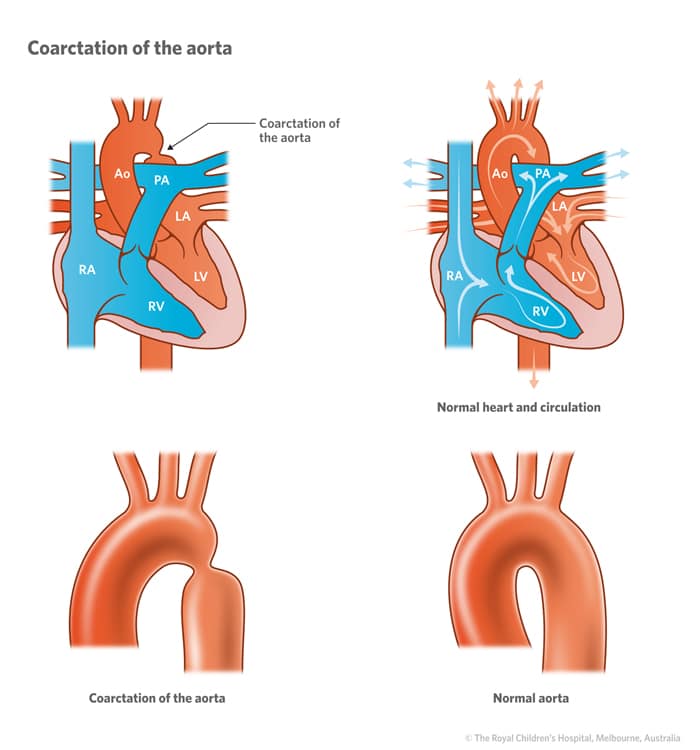How Is The Problem Treated
Management of the individual with coarctation of the aorta must be individualized. In the children without symptoms, in who a coarctation is diagnosed on routine examination, repair of the coarctation, either surgically or using balloon angioplasty at a cardiac catheterization is usually recommended by 18-24 months of age.
In the newborn or infant with coarctation who presents with congestive heart failure, initial treatment consists of stabilizing the infant with medications. These medications include agents that increase the strength of the heartbeat inotropic agents and medicines that help the body remove excess fluids, diuretics. If the infant is less than 2 weeks of age the baby will receive a medicine to open the ductus arteriosus, prostaglandin E1, and the most critically ill babies will require the use of a ventilator to help the baby breathe. After a brief period of stabilization, infants with coarctation and congestive heart failure require surgical repair.
Surgical repair involves removing the narrowed segment of aorta and reconnecting the ends directly. Although rare, in some children it is necessary to place a piece of artificial material to enlarge or bypass the area of narrowing.
Balloon angioplasty is performed at the time of a heart catheterization. The angioplasty involves the placement of a special balloon catheter across the narrowed area and then inflating the balloon and thereby stretching open the aorta.
What Is The Most Common Site Of Coarctation Of The Aorta
Coarctation of the aorta usually occurs in your babys descending aorta near their ductus arteriosus. But it can also happen in other parts of their aorta. These include other areas of the aortic arch or further down in your babys chest or belly.
Your babys aorta is a long, curved blood vessel that arches upward from the top of their heart and then curves down through their chest and belly. Its shaped like a walking cane with a round handle. The handle curves upward and then downward . The top of that curve is called the aortic arch.
The location of aortic coarctation matters because it affects your babys symptoms. You can think of your babys aorta like a main road that has lots of intersections. At each intersection, another artery or group of arteries connects with the aorta and carries blood in a different direction.
Aortic coarctation often occurs between two major intersections. The first is where arteries branch off to the upper body. The second is where arteries branch off to the lower body. So, blood leaves your babys heart and travels along just fine. It reaches the first intersection and easily flows into the arteries that lead to your babys upper body. Meanwhile, some blood keeps moving along in their aorta. And soon it runs into trouble.
How Is Coarctation Of The Aorta Diagnosed
Doctors may refer a child with the signs or symptoms of COA to a pediatric cardiologist . The cardiologist will listen to the heart, feel the pulses, and check blood pressure.
The cardiologist might order an echocardiogram a test that uses sound waves to create a picture of the heart and its circulation and other tests that produce images of the heart, like a chest X-ray, a magnetic resonance imaging test, or a computerized tomography scan.
COA must be treated quickly because it can cause high blood pressure and enlarge the heart. It also can cause dissection or rupture of the aorta, which can be fatal. Severe coarctations usually are found shortly after birth and repaired by surgery immediately.
Read Also: How To Check Blood Pressure By Hand
How Is Coarctation Of The Aorta Treated
Coarctation of the aorta is treated by removing or patching the narrow part of the vessel. Newborns who are very sick and require care in the cardiac intensive care unit may need urgent repair of the coarctation.
For most infants, surgery is the standard treatment. The surgeon cuts out the narrowed segment and sews the two healthy ends of the aorta back together, establishing normal blood flow through the vessel.
If the child also has a large ventricular septal defect, our surgeons usually repair the defect at the same time as the coarctation. If there’s a bicuspid aortic valve, it will need to be followed by your cardiologist to make sure that no blockage or leakage develop later.
Some patients have narrowing of the aortic arch as well. In this case, our surgeons will repair the arch and coarctation at the same time using the heart/lung machine. Depending on the anatomy, this repair can be achieved with all natural tissue or a patch.
In a small percentage of patients, the narrowing can return. In that small number of cases, a catheterization with balloon dilation is very effective. Rarely, a stent is required.
Causes And Risk Factors

The causes of heart defects, including coarctation of the aorta, among most babies are unknown. Some babies have heart defects because of changes in their genes or chromosomes. Heart defects, like coarctation of the aorta, are also thought to be caused by a combination of genes and other risk factors, such as things the mother comes in contact with in the environment, what the mother eats or drinks, or medicines the mother uses.
Don’t Miss: Can Garlic Lower Your Blood Pressure
Predictors Of Ambulatory Blood Pressure And Carotid Imt
Figure shows the relation between common carotid IMT and the site of repair/diaphragmatic aorta ratio in the 73 patients with no or only mild residual aortic narrowing. When corrected for significant confounders in multivariable analysis the relation was still significant . Figure shows the relation between mean daytime systolic blood pressure and the site of repair/diaphragmatic aorta ratio in these 73 patients. When corrected for significant confounders in multivariable analysis the relation was highly significant.
What Is Coarctation Of The Aorta In Children
Coarctation of the aorta is a heart defect that is present at birth . It means the aorta is narrower than it should be. The aorta is the large artery that carries oxygen-rich blood from the left ventricle to the body. This narrowing means that less oxygen-rich blood is sent to the body.
The amount of narrowing can vary. A child with greater narrowing of the aorta will have more symptoms. The symptoms will also be seen at an early age. In some cases, coarctation is seen in infancy. In others, it may not be seen until school-age or teen years. COA may be diagnosed in babies, school-age children, or teens. It is more often seen in males. There is an increased chance of having the condition if another family member has it. It also occurs more often in certain genetic syndromes such as Turner Syndrome. Coarctation of the aorta is often linked to other cardiac defects. These include a bicuspid aortic valve.
Don’t Miss: Is Sea Moss Good For Diabetes And High Blood Pressure
What Are Possible Complications Of Coa In A Child
If untreated, COA causes several problems:
-
The left ventricle, which pumps blood through the aorta and to the body, becomes weak and fails
-
Blood pressure is too high in the upper body and too low in the lower body
-
Kidneys don’t work as they should
-
Coronary artery disease
-
Infection of the heart and blood vessel wall
-
The aorta or other arteries can tear, causing uncontrolled bleeding or stroke
How Can Parents Help
If your child has COA or has had a coarctation repaired, call the doctor if you see shortness of breath, chest pain, or fainting.
Overall, kids who have had the condition can expect to lead a normal life after treatment.
If your child has COA, it can feel overwhelming. But you’re not alone. The care team is there to support you and your child. Be sure to ask when you have questions.
You also can find more information and support online at The American Heart Association.
Don’t Miss: How To Get Systolic Blood Pressure Down
Why Is Leg Blood Pressure Higher Than Arm
It has been recognized for some time that systolic pressures at the level of the ankles can also be elevated in comparison to pressures measured in the arm. This is usually attributed to calcification of the arteries, which prevents arterial compression and results in a falsely elevated pressure measurement.
Long Term Health Implications
Coarctation of the aorta is not a focal disease that can be fixed with a stent or surgery. The aorta itself is often abnormal there is reduced elastic tissue and more fibrous tissue leading to increased aortic stiffness. This stiffness will persist after the narrowing has been dealt with through either surgery or a stent procedure. About 30 percent of patients who have coarctation that is repaired will continue to be on medication for high blood pressure.
The heart muscle is similar to other muscles in the body – the harder it is forced to work, the thicker it will become. The increased aortic stiffness and the narrowing of the aorta at the site of the coarctation means the the heart has to continuously work harder to push blood to the body. As a result there may be an enlargement of the aorta or walls of the heart. When we follow patients with coarctation we will usually perform an imaging study every few years for surveillance, to keep an eye on the aorta.
Untreated or inadequately controlled high blood pressure is a problem. Uncontrolled high blood pressure over time can lead to severe conditions such as stroke, coronary artery disease , heart attacks, brain aneurysms or brain hemorrhages. When we see patients with coarctation we focus on blood pressure control as part of the visit. Getting control of the blood pressure is helped by maintaining a healthy weight and diet, moderating alcohol, and sometimes will require medication for life.
Open Heart Surgery
Also Check: Apple Cider Vinegar Dose For High Blood Pressure
Other Factors Influencing Ht
Age at repair was the main determinant of HT in various studies, with older age at repair being associated with an increased incidence of HT , but not in the studies of Bambul Heck et al. and Rinnström et al. .
The type of repair was also found to be important. Giordano et al. , compared a group of patients with isolated CoA with patients having CoA as part of a complex congenital heart disease . Although patients with isolated CoA were significantly younger, they had a markedly higher incidence of HT . They postulated that in the complex CHD group, the incidence of HT was lower because the aortic repair was more effective than in those with isolated CoA, possibly due to less residual aortic arch hypoplasia through aortic arch enlargement with a pulmonary homograft patch. Martins et al. failed to demonstrate that the type of repair was predictive for vascular function differences and HT when comparing surgery vs. balloon dilatation vs. stents .
Patients treated in different eras were compared by Dijkema et al. . They now favor enlarging the transverse arch, as it has been shown that catch-up growth of arch hypoplasia after end-to-end anastomosis does not always occur .
The increased risk of a cerebro-vascular accident after coarctation repair was found to be three-fold, with HT the single best predictor of CVA .
What Age Does Coarctation Of Aorta Present

Coarctation of the aorta is present from birth. The age at which coarctation is detected depends on the severity of the narrowing. In approximately 25 percent of cases of isolated coarctation, the narrowing is severe enough to cause symptoms in the first days of life when the ductus arteriosus closes.
Don’t Miss: Does Drinking Water Help High Blood Pressure
Leg Pulses And Blood Pressure In Coarctation Of The Aorta
1. When should you suspect coarctation of the aorta?
ANS: In any patient with hypertension.
2. What are the characteristics of the pulses proximal to and beyond an aortic coarctation?
ANS: The proximal pulses, i.e., the carotid and brachial pulses, are large, bounding pulses. The parts of the body beyond the coarctation receive blood through enlarged collaterals that do not transmit the percussion wave well. Therefore, not only do the lower extremity pulses have a low pulse pressure, but also their rate of rise is slow and they have a late peak, i.e., the pulse wave is almost purely a tidal wave.
Note: The blanching time is normally about 1.3 s in the toes, but averages over 3 s in the presence of coarctation.
3. If the onsets of the femoral and radial pulses are almost simultaneous, what causes the sensation of the delayed peak in the femorals?
ANS: Because of the decreased initial flow rate through the femorals, their percussion wave is so low that only the tidal wave is felt in the femorals.
Onset almost simultaneous
What Are The Signs & Symptoms Of Coa
Abnormal blood pressure is often the first sign of COA. During a physical exam, a doctor may find that a child with a coarctation has higher blood pressures in the arms than in the legs. The doctor also might hear a heart murmur or notice that the pulse in the groin is weak or hard to feel. Any person diagnosed with high blood pressure should be checked for coarctation of the aorta.
Often, kids don’t have any symptoms and the COA is discovered during a regular visit to the doctor. Kids who do have symptoms might have:
- cold legs and feet
- shortness of breath, especially when exercising
You May Like: What Should Your Normal Blood Pressure Be
What Causes Coarctation Of The Aorta
The exact cause of coarctation of the aorta isnt fully known. However, congenital heart defects are often caused by genetic changes that happen before birth. Babies with Turner syndrome have a higher risk of aortic coarctation and other defects that affect the left side of their heart.
Sometimes, environmental factors play a role in causing heart defects, too. These are factors related to the birthing parent. They include:
- Being over age 35.
The role of the ductus arteriosus
The ductus arteriosus may cause coarctation of the aorta. The ductus arteriosus is a small artery that connects the fetal aorta and pulmonary artery. It helps your fetus get enough oxygen-rich blood during gestation when their lungs arent working yet.
Once your baby is born, their lungs start working. That means they dont need the ductus arteriosus anymore. So, it usually closes up within a few days of birth. But when it closes, something may go wrong. Some tissue from the ductus arteriosus may blend in with tissue from their aorta. When this tissue tightens to close up the ductus arteriosus, it may narrow their aorta as well and lead to coarctation.
Pathophysiology Of Coarctation Of The Aorta
Physiologic consequences involve 2 phenomena:
-
Pressure overload in the arterial circulation proximal to the coarctation
-
Hypoperfusion distal to the coarctation
Pressure overload causes left ventricular hypertrophy and hypertension in the upper part of the body, including the brain.
Hypoperfusion affects the abdominal organs and lower extremities. Malperfusion of the intestine increases the risk of sepsis due to enteric organisms.
Ultimately, the pressure gradient increases collateral circulation to the abdomen and lower extremities via intercostal, internal mammary, scapular, and other arteries.
or rupture later in life or in association with pregnancy. The ascending aorta is the area most frequently involved in dissection or rupture. Current data suggest that this risk is less likely a direct consequence of the coarctation and more likely related to a bicuspid aortic valve Bicuspid Aortic Valve Bicuspid aortic valve is the presence of only two valve cusps. Bicuspid aortic valve is the most common congenital cardiovascular abnormality. It is present in… read more and associated aortopathy.
Also Check: Blood Pressure 160/100 How Bad Is It
How Does Coarctation Affect Me
Many people don’t know there’s a problem. High blood pressure in the arms is typical. When present in a young person, it should prompt investigation for coarctation. Sometimes adults may have headaches, renal problems frequent miscarriages, or lack of energy when using their legs. However, such symptoms are common in the general population and are usually due to other causes.
Can Aortic Coarctation Be Prevented
Theres no specific way to prevent aortic coarctation. But prenatal care may impact your babys chances of having congenital heart disease. If youre pregnant or planning a pregnancy, its important to:
- Quit smoking and avoid drinking alcohol.
- Avoid secondhand smoke.
- Avoid using recreational drugs, especially cocaine.
Talk with your provider about any concerns you have. Genetic testing may be helpful if you or other biological family members have congenital heart disease.
Read Also: How To Read Blood Pressure Cuff
What About Preventing Endocarditis
Children with coarctation of the aorta may risk developing endocarditis. Your child’s cardiologist may recommend that your child receive antibiotics before certain dental procedures for a period of time after coarctation repair. See the section on Endocarditis for more information.
Will I Need More Surgery

The need for surgery or catheterization depends mostly on the level of pressure in your arms and legs when you’re resting and, under some circumstances, during exercise. If your arm and leg blood pressures are normal and equal, you probably won’t need more intervention. If you blood pressure is elevated in your arms and more than 20 mmHg higher than in your legs, it is likely further intervention will be needed. When problems occur, more and more institutions use catheters rather than surgery, which is much easier for the patient.
Written by American Heart Association editorial staff and reviewed by science and medicine advisers. See our editorial policies and staff.
Last Reviewed: Mar 23, 2022
Read Also: What Foods Cause High Blood Pressure